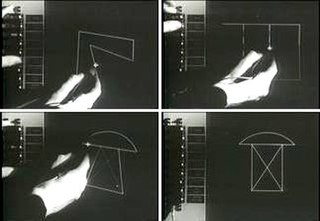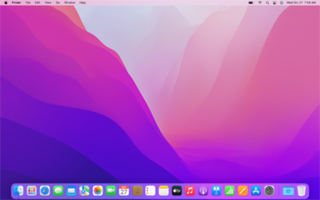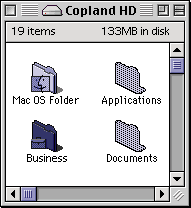
The history of the graphical user interface, understood as the use of graphic icons and a pointing device to control a computer, covers a five-decade span of incremental refinements, built on some constant core principles. Several vendors have created their own windowing systems based on independent code, but with basic elements in common that define the WIMP "window, icon, menu and pointing device" paradigm.

macOS is a proprietary graphical operating system developed and marketed by Apple Inc. since 2001. It is the primary operating system for Apple's Mac computers. Within the market of desktop and laptop computers it is the second most widely used desktop OS, after Microsoft Windows and ahead of Chrome OS.

GNUstep is a free software implementation of the Cocoa Objective-C frameworks, widget toolkit, and application development tools for Unix-like operating systems and Microsoft Windows. It is part of the GNU Project.
Carbon was one of two primary C-based application programming interfaces (APIs) developed by Apple for the macOS operating system. Carbon provided a good degree of backward compatibility for programs that ran on Mac OS 8 and 9. Developers could use the Carbon APIs to port (“carbonize”) their “classic” Mac applications and software to the Mac OS X platform with little effort, compared to porting the app to the entirely different Cocoa system, which originated in OPENSTEP. With the release of macOS 10.15 Catalina, the Carbon API was officially discontinued and removed, leaving Cocoa as the sole primary API for developing macOS applications.
In computing, a desktop environment (DE) is an implementation of the desktop metaphor made of a bundle of programs running on top of a computer operating system that share a common graphical user interface (GUI), sometimes described as a graphical shell. The desktop environment was seen mostly on personal computers until the rise of mobile computing. Desktop GUIs help the user to easily access and edit files, while they usually do not provide access to all of the features found in the underlying operating system. Instead, the traditional command-line interface (CLI) is still used when full control over the operating system is required.
ShapeShifter is an Application Enhancer (APE) plugin for Mac OS X developed by Unsanity that allows the user to make system-wide modifications to the appearance of the operating system's graphical interface by applying GUI skins through "injection" into running code and without modifying system files, very much like Kaleidoscope or WindowBlinds. It uses GUIKit files which can contain interface elements, desktop backgrounds and icons. GUIKit files are most often edited using a program called ThemePark.

System 7, codenamed "Big Bang", and also known as Mac OS 7, is a graphical user interface-based operating system for Macintosh computers and is part of the classic Mac OS series of operating systems. It was introduced on May 13, 1991, by Apple Computer, Inc. It succeeded System 6, and was the main Macintosh operating system until it was succeeded by Mac OS 8 in 1997. Features added with the System 7 release included virtual memory, personal file sharing, QuickTime, QuickDraw 3D, and an improved user interface.

System 6 is a graphical user interface-based operating system for Macintosh computers, made by Apple Computer, Inc. It was released in 1988, and is part of the classic Mac OS series. It is a monolithic operating system, with cooperative multitasking based on an improved MultiFinder. The boxed version cost US$49, and it was included with all new Macintosh computers until 1991, when it was succeeded by System 7.

Aqua is the graphical user interface, design language and visual theme of Apple's macOS operating system. It was originally based on the theme of water, with droplet-like components and a liberal use of reflection effects and translucency. Its goal is to "incorporate color, depth, translucence, and complex textures into a visually appealing interface" in macOS applications. At its introduction, Steve Jobs noted that "... it's liquid, one of the design goals was when you saw it you wanted to lick it".

Mac OS 8 is an operating system that was released by Apple Computer, Inc. on July 26, 1997. It includes the largest overhaul of the classic Mac OS experience since the release of System 7, approximately six years before. It places a greater emphasis on color than prior versions. Released over a series of updates, Mac OS 8 represents an incremental integration of many of the technologies which had been developed from 1988 to 1996 for Apple's overly ambitious OS named Copland. Mac OS 8 helped modernize the Mac OS while Apple developed its next-generation operating system, Mac OS X.

In computing, a theme is a preset package containing graphical appearance and functionality details. A theme usually comprises a set of shapes and colors for the graphical control elements, the window decoration and the window. Themes are used to customize the look and feel of a piece of computer software or of an operating system.

The spinning pinwheel is a variation of the mouse pointer arrow, used in Apple's macOS to indicate that an application is busy.
Resolution independence is where elements on a computer screen are rendered at sizes independent from the pixel grid, resulting in a graphical user interface that is displayed at a consistent size, regardless of the resolution of the screen.
Apple's Macintosh computer supports a wide variety of fonts. This support was one of the features that initially distinguished it from other systems.

Windows XP visual styles are customizations of the graphical user interface of Windows XP. "Luna", "Royale", "Zune", and "Embedded" are codenames of the official visual styles designed for Windows XP by Microsoft. Since Windows XP, themes include the choice of visual styles as well. By default, "Luna" is preinstalled on Windows XP Home and Professional editions, "Royale" is preinstalled on Windows XP Media Center Edition and "Embedded" is preinstalled on Windows Embedded Standard 2009 and Windows Embedded POSReady 2009. In addition to the preinstalled visual styles, Microsoft has released additional ones for download. Third parties have also released visual styles, though these require modification of core Windows components to work. Visual styles are compatible with all Windows XP editions except Starter Edition.

Workbench is the graphical file manager of AmigaOS developed by Commodore International for their Amiga line of computers. Workbench provides the user with a graphical interface to work with file systems and launch applications. It uses a workbench metaphor for representing file system organisation.
Brushed metal is a discontinued graphical user interface design used in Apple Computer's Mac OS X operating system for Macintosh computers. The first of Apple's applications to sport this look was the QuickTime Player released as part of QuickTime 4.0 in 1999.

Kaleidoscope is a third party theme manager for Mac OS 7 and 8, written by Arlo Rose and Greg Landweber. It utilizes a proprietary framework to apply "schemes" to the Macintosh GUI, long before Apple released the Appearance Manager system with Mac OS 8. Whereas only a few Appearance Manager themes were ever developed, tens of thousands of Kaleidoscope schemes were developed.

The classic Mac OS is the series of operating systems developed for the Macintosh family of personal computers by Apple Inc. from 1984 to 2001, starting with System 1 and ending with Mac OS 9. The Macintosh operating system is credited with having popularized the graphical user interface concept. It was included with every Macintosh that was sold during the era in which it was developed, and many updates to the system software were done in conjunction with the introduction of new Macintosh systems.














